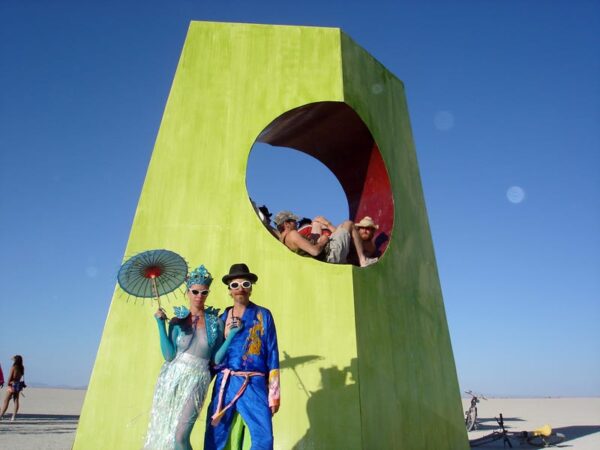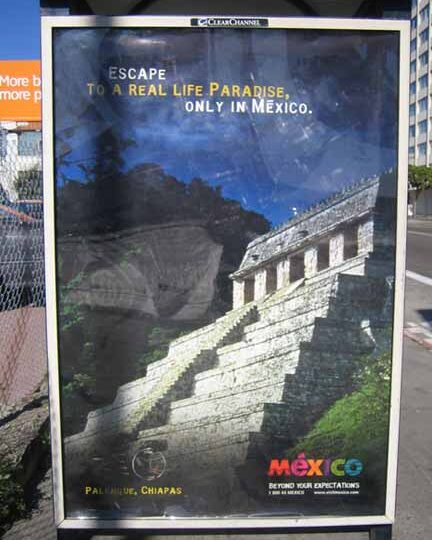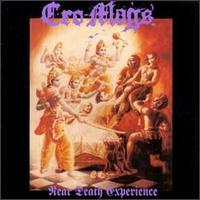
Sacred Geometry on the Playa
I first met Harlan Gruber about 15 years ago in some artist warehouse in Brooklyn, where he had landed after touring the country visiting intentional communities. We talked about UFOs, and subsequently became friends. So you could say that I am biased, but Harlan is, for me, one of the best creators of large-scale interactive art at Burning Man. And I place this entire opinion on the strength of one work: 2004’s Diamond Portal. Subtler and more soberly mystic than most playa art, the Diamond Portal featured most of the elements I truly relish out there: mellow interactivity, visual clarity, soundscape, and a sense of transition into something genuinely marvelous and strange. The sunset hour I spent in its cylindrical hole intoning nameless mantras with Harlan and Jimmy Whiz was one of the most peaceful and sustaining trances I have experienced on the playa.
Accompanying our wayward Oms was the Quasar Wave Transducer, a gizmo hidden in the bowels of the acid green monolith. A device first envisioned by Harlan in the early 1980s, the Transducer is a triangular speaker cabinet with attached bass guitar strings strung over pickups; the humming of the tunable strings is amplified through the speakers, which in turn vibrate the strings, creating an infinite positive feedback loop that, when placed inside a sizable chunk of playa architecture like the Portal, created a resonating, oceanic womb-henge, at once crystal wormhole and cosmic crib. Placed at 11:11 on the clock-face that describes Black Rock City—a number and ratio seen by New Ager consciousness surfers as a major dimensional portal—the Diamond Portal managed to incarnate SciFi sacred geometry, minimalist design, and an excellent color scheme into a playful temple for lovers of the drone. As Robert Christgau sometimes says: A+
Harlan built the Diamond Portal on his own dime, and I was surprised when he did not get a grant next year for his Emerald Portal, a rich elaboration of the Diamond Portal that manifested itself in a much reduced but still charming form during the festival last summer. In its original plans, the Emerald Portal resembled my own sense of what a fully-loaded, hopped-up, and quantum-injected Merkabah might look like. Definition time: the Merkabah is the “chariot” of ancient Jewish apocalypticism, a literature of visionary journeying that spun off from the enigmatic craft Ezekiel glimpses in the Bible. The Merkabah has also been remixed by New Age seers like Drunvalo Melchizedek into a sort of geometrical soul-pod for the astral immensities that await, on the far side of death or spacetime implosion, whichever comes first. Harlan is way into this stuff, and though I am not a believer, his intense engagement with sacred geometry just makes his work more interesting to me. Unlike many Burning Man artists, he is not resting content with surrealistic shock or wacky-assed juxtaposition: he is building a fucking portal into the far side of the end times.
When Harlan told me his plans for the Sapphire Portal this year, I thought he was a shoe-in for a grant. A large circular wall will enclose a sky-blue chill-out space whose center is taken up by three nested geometric shapes whose proportions have something to do with the earth’s magnetic field or energetic pattern or something like that. The half dodecahedron in the center will house the Quasar Wave Transducer, and “white cloud cushions” nearby will allow full immersion.
The Sapphire Portal seems perfect for the deep playa, but Harlan’s plans were rejected yet again. Though I am now on the board of the Black Rock Arts Foundation, I have until recently made it a personal policy to pay as little attention to Borg decision-making as possible, so I don’t understand what’s up. I admire the arts administration there a great deal, but I suspect that it might have something to do with the New Age undertow of the project, or perhaps the transpersonal minimalism of Harlan’s design.
In any case, Harlan is forging ahead, manifesting his intention to build an “evolutionary interface.” Photographs of the Sapphire Portal are online, and Harlan is aiming to raise funds for construction through donations and the sale of nifty Sapphire Portal pendants made of silver and pewter. You can also pick up some classic Diamond Portal pendants, which remain some of my most-prized Black Rock schwag. The cost of the Sapphire pendants depend on the material, but the Diamond Portal ones are $11.11, and, as Harlan puts it, they “make great gifts as well being symbols of evolutionary transformation.”




